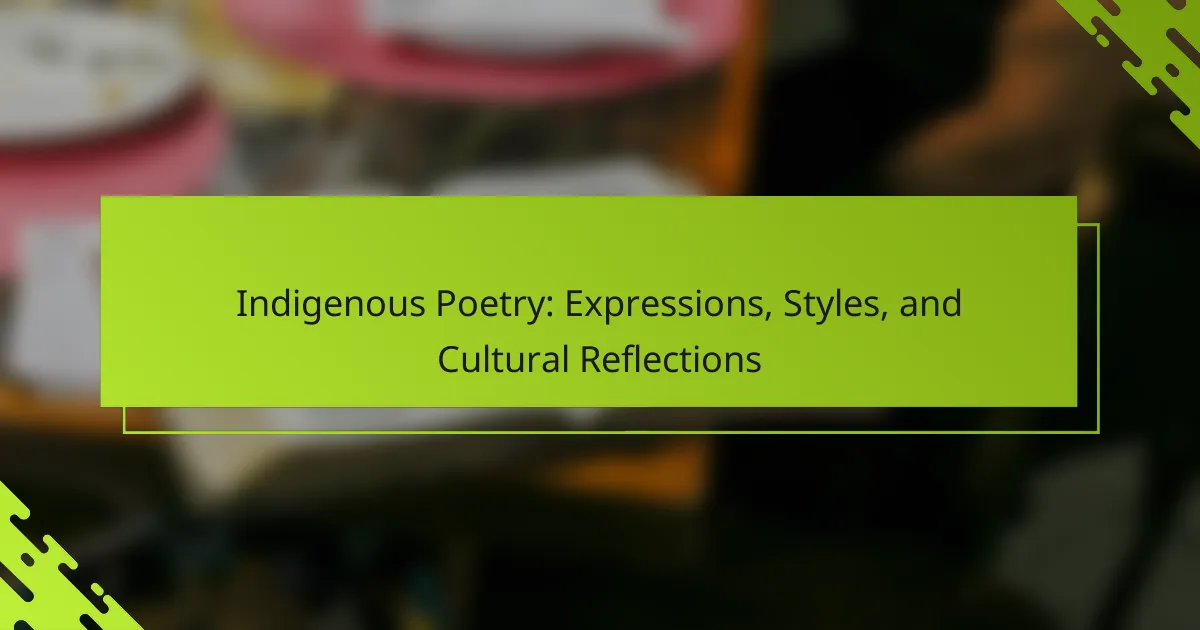Indigenous poetry offers profound insights into cultural identity, nature, and communal experiences. It showcases diverse styles influenced by oral traditions and modern adaptations. Key themes include identity, place, and the impact of colonisation. Language plays a crucial role, enhancing the expression of unique cultural narratives and fostering community engagement.

What are the core elements of Indigenous poetry?
Indigenous poetry encompasses core elements such as oral tradition, cultural identity, and connection to nature. These elements express the unique experiences and histories of Indigenous peoples. Oral tradition serves as a primary form of storytelling, preserving knowledge and values across generations. Cultural identity is reflected through themes, language, and symbolism, showcasing the distinctiveness of various Indigenous groups. Connection to nature emphasizes the relationship between people and their environment, often invoking imagery and elements from the natural world. These attributes create a rich tapestry of expression that resonates deeply within Indigenous communities.
How do cultural narratives shape Indigenous poetic expressions?
Cultural narratives profoundly influence Indigenous poetic expressions by embedding history, identity, and spirituality within the art form. These narratives shape themes, styles, and language, reflecting communal values and beliefs.
Indigenous poetry often incorporates oral traditions, storytelling techniques, and metaphors drawn from nature. This unique attribute fosters a deep connection to the land and ancestors, enriching the poetic experience.
Additionally, cultural narratives serve as a vehicle for resistance and resilience, addressing social issues and historical injustices. As a result, Indigenous poetry becomes a powerful medium for cultural preservation and revitalisation.
Through these expressions, poets convey collective memories and aspirations, ensuring that Indigenous voices resonate within contemporary discourse.
What role does oral tradition play in Indigenous poetry?
Oral tradition is vital in Indigenous poetry as it preserves cultural narratives and values. This form of storytelling connects generations through shared experiences and collective memory. Oral traditions enhance the poetic form, incorporating rhythm and performance, making it a dynamic expression of identity. Additionally, these traditions often include unique attributes, such as specific dialects or regional storytelling techniques, which enrich the diversity of Indigenous poetry.
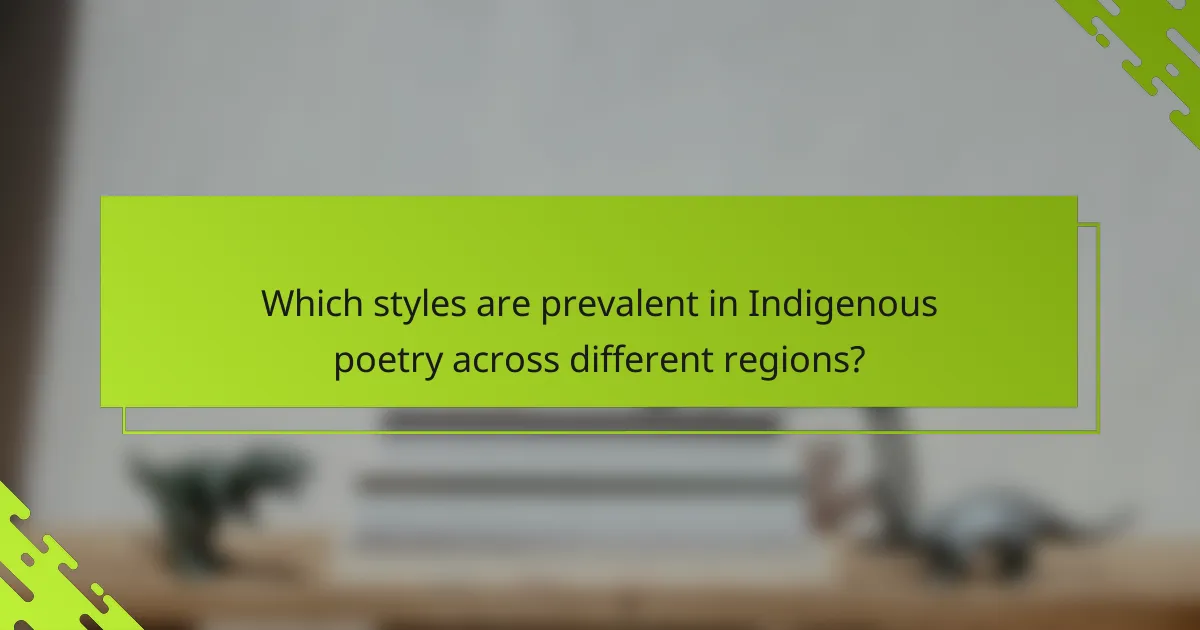
Which styles are prevalent in Indigenous poetry across different regions?
Indigenous poetry features diverse styles influenced by cultural heritage and regional characteristics. Common styles include oral traditions, narrative forms, and modern adaptations.
Oral poetry is prevalent in many Indigenous cultures, emphasizing storytelling and communal experiences. For instance, Native American poetry often incorporates nature imagery and spiritual themes, reflecting connections to the land.
In contrast, Australian Indigenous poetry frequently utilizes contemporary language while maintaining traditional storytelling elements, showcasing unique cultural perspectives.
African Indigenous poetry varies widely, with some regions focusing on rhythmic patterns and communal songs, while others emphasize personal narratives and social commentary. Each style serves as a cultural reflection, preserving history and identity.
How do contemporary forms of Indigenous poetry differ from traditional styles?
Contemporary forms of Indigenous poetry often incorporate modern themes and diverse styles, contrasting with traditional forms that focus on cultural heritage and oral storytelling. Contemporary poets frequently blend genres, utilise technology, and address current social issues. Traditional poetry emphasizes community, spirituality, and ancestral connections, often adhering to specific structures and rhythms. This evolution reflects a unique attribute of contemporary Indigenous poetry, showcasing its adaptability and relevance in today’s society.
What unique stylistic features are found in Indigenous poetry from specific communities?
Indigenous poetry exhibits unique stylistic features that reflect cultural heritage and community identity. These features include oral traditions, use of metaphors, and incorporation of nature imagery.
Oral traditions play a vital role, as many Indigenous poems are rooted in storytelling, preserving history and wisdom. Metaphors are often drawn from the environment, creating deep connections between the community and its land. Nature imagery is prevalent, symbolising spiritual beliefs and the interconnectedness of life.
Additionally, rhythmic patterns and repetition enhance the musical quality of the poetry, making it memorable and impactful. Each community may have distinct styles, reflecting their unique experiences and cultural narratives.
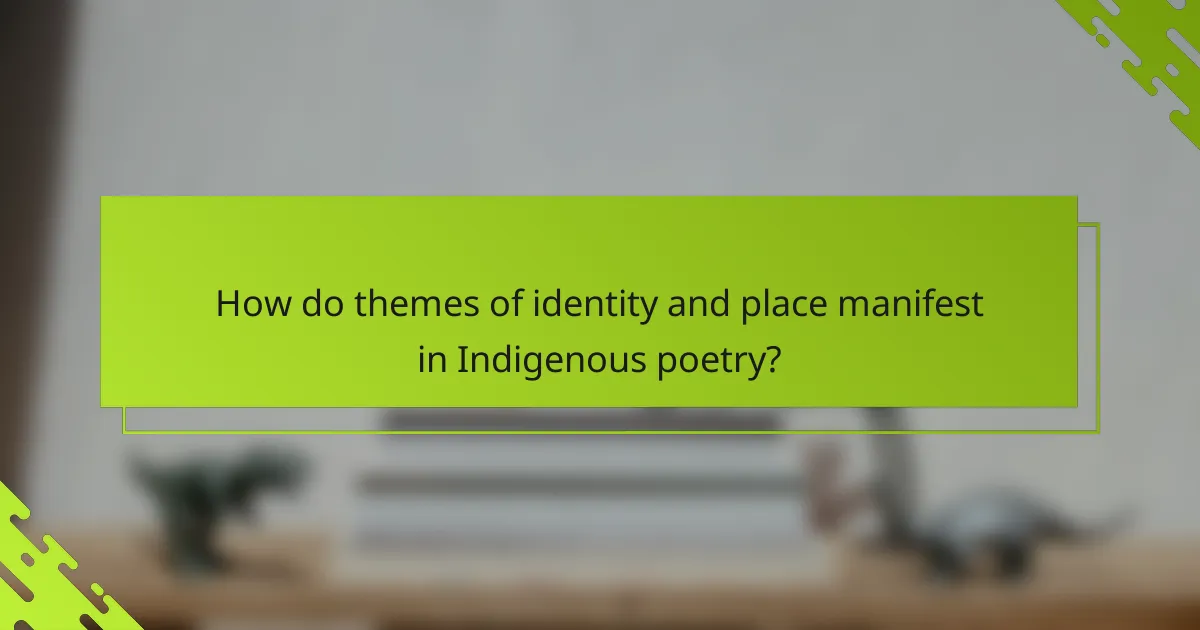
How do themes of identity and place manifest in Indigenous poetry?
Themes of identity and place deeply manifest in Indigenous poetry through personal and communal narratives. Poets express their cultural heritage, connection to land, and the impact of colonisation. The use of specific imagery and language reflects unique attributes of Indigenous identities and experiences. This expression often emphasizes the importance of place, linking identity to geography and ancestral ties. As a result, Indigenous poetry serves as a powerful medium for cultural reflection and resilience, showcasing the richness of Indigenous worldviews.
Why is connection to land significant in Indigenous poetic works?
Connection to land is significant in Indigenous poetic works as it embodies cultural identity and spiritual ties. Land serves as a source of inspiration, reflecting the relationship between people and nature. Indigenous poets often use land as a metaphor for resilience and belonging. This connection fosters a sense of community and continuity, linking past, present, and future generations. Through vivid imagery and storytelling, these works convey the deep respect and understanding of the land’s role in shaping cultural narratives.
How do Indigenous poets address social and political issues through their art?
Indigenous poets address social and political issues through their art by weaving personal narratives with collective experiences. They often highlight themes of identity, land rights, and cultural preservation. For instance, poets may use metaphor and imagery to critique colonialism and advocate for social justice. Their work serves as a powerful medium for raising awareness and fostering dialogue on pressing issues faced by Indigenous communities. This artistic expression not only preserves cultural heritage but also empowers future generations to engage with their history and advocate for change.
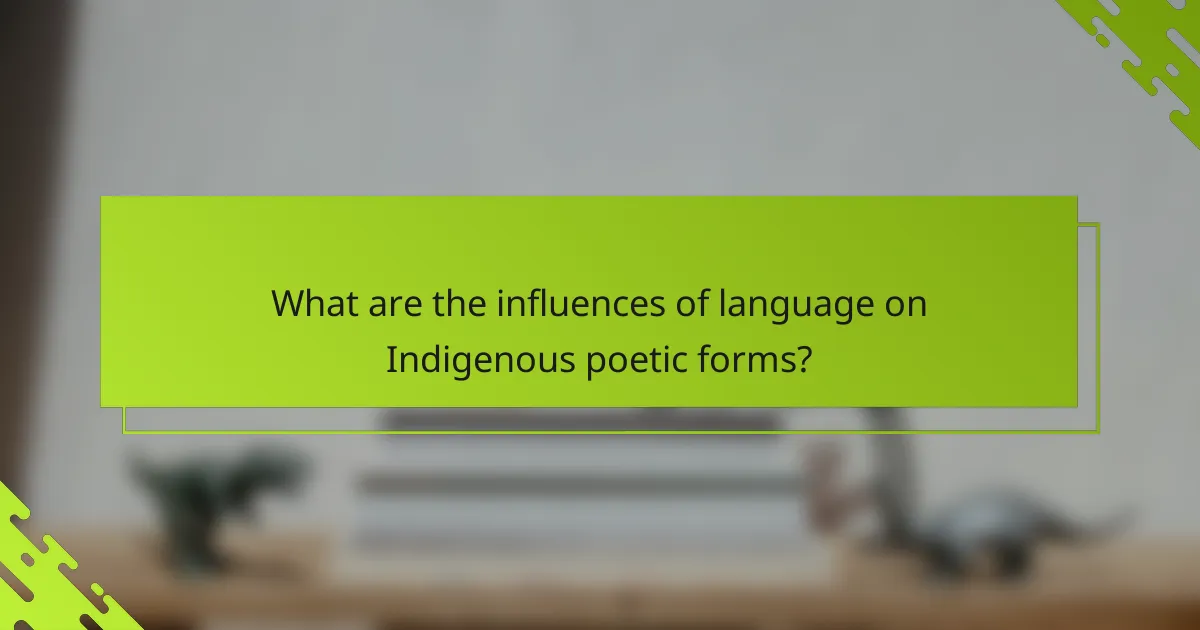
What are the influences of language on Indigenous poetic forms?
Language significantly influences Indigenous poetic forms by shaping their structure, themes, and cultural significance. Indigenous poetry often incorporates native languages, which carry unique sounds, meanings, and rhythms that enhance the expression of identity and connection to land. The use of metaphor and symbolism in these languages reflects deep cultural narratives and ancestral wisdom, making the poetry a vital medium for storytelling and preserving traditions. Additionally, language serves as a vehicle for community engagement, allowing poets to convey collective experiences and social issues relevant to their communities. The interplay between language and poetic form highlights the richness and diversity of Indigenous cultures.
How does the use of native languages enrich the meaning of poems?
The use of native languages enriches the meaning of poems by deepening cultural connections and preserving unique expressions. Indigenous poetry often incorporates specific linguistic elements that convey emotions and concepts not easily translated into dominant languages. This linguistic richness allows for a more profound exploration of identity, tradition, and community values. Moreover, native languages can evoke distinct imagery and rhythm, enhancing the overall aesthetic experience of poetry. The cultural nuances embedded in these languages create layers of meaning, making the poems resonate more deeply with both Indigenous and broader audiences.
Which challenges do poets face when writing in Indigenous languages?
Poets writing in Indigenous languages face significant challenges, including limited resources and support. Many Indigenous languages are endangered, leading to a scarcity of vocabulary and linguistic tools. Additionally, poets often navigate cultural nuances that require deep understanding and respect for traditions. Access to audiences familiar with these languages can also be restricted, impacting the dissemination of their work. Finally, poets may confront the challenge of balancing modern themes with traditional storytelling methods, which can complicate their creative expression.
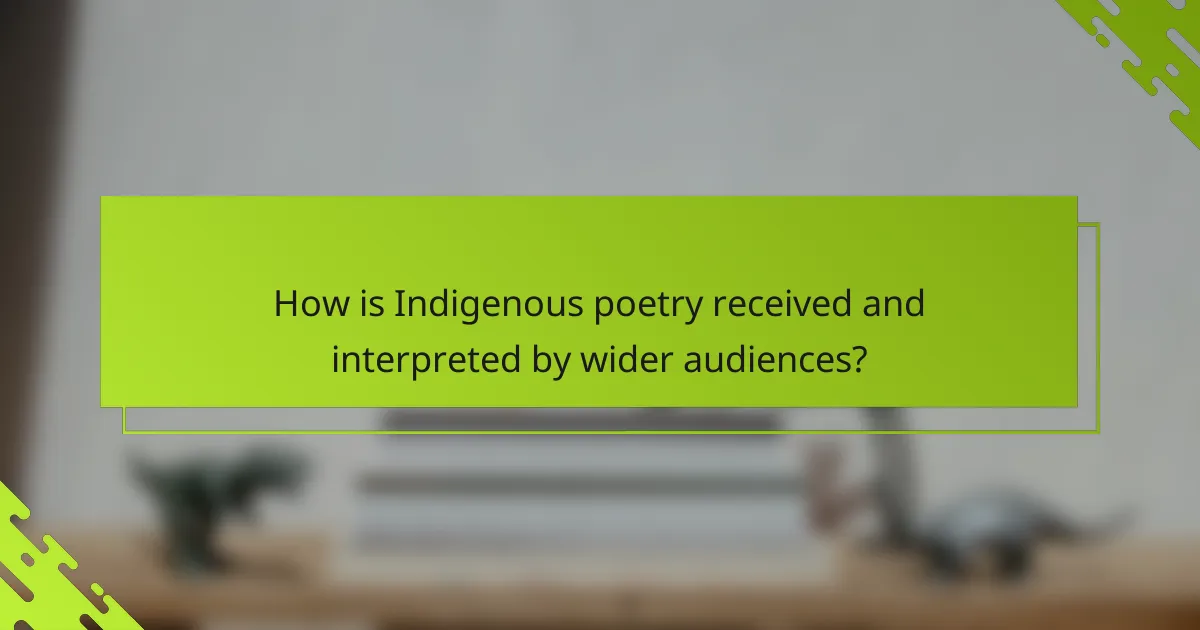
How is Indigenous poetry received and interpreted by wider audiences?
Indigenous poetry is often received with respect and curiosity, though interpretations vary. Wider audiences may appreciate its rich cultural narratives and emotional depth, which can challenge preconceived notions. The unique attributes of Indigenous poetry, such as its oral traditions and connection to land, offer fresh perspectives that resonate with diverse readers. As a result, this poetry fosters a deeper understanding of Indigenous experiences and histories, bridging cultural gaps.
What impact does translation have on the essence of Indigenous poetry?
Translation can significantly alter the essence of Indigenous poetry by reshaping cultural nuances and emotional depth. The original language often carries unique sounds, rhythms, and meanings that may not fully transfer to another language. This loss can dilute cultural identity and context, impacting how the poetry resonates with readers. The distinct imagery and symbolism rooted in Indigenous experiences might become obscured, leading to a diminished understanding of the cultural reflections encapsulated in the poetry. Ultimately, while translation can broaden access, it risks oversimplifying the rich tapestry of Indigenous voices and perspectives.
How do cultural misunderstandings affect the appreciation of Indigenous poetic works?
Cultural misunderstandings significantly hinder appreciation of Indigenous poetic works by obscuring their meanings and contexts. Misinterpretations arise when external audiences lack knowledge of the cultural, historical, and spiritual backgrounds that shape these expressions.
Indigenous poetry often employs unique attributes such as oral traditions and metaphors rooted in specific cultural narratives. When these elements are overlooked, the richness of the poetry diminishes, leading to superficial engagement. As a result, Indigenous voices may be marginalised in broader literary discussions, affecting their visibility and impact.
Moreover, rare attributes like the use of native languages can pose additional barriers. Non-speakers may miss nuances and emotional depth, further complicating cross-cultural appreciation. This disconnect can perpetuate stereotypes and reinforce cultural insensitivity, undermining the intended messages of the works.
To foster genuine appreciation, it is essential to promote cultural education and awareness. Engaging with Indigenous communities and their literary traditions can bridge gaps and enhance understanding, allowing for a more profound connection to the poetry’s essence.
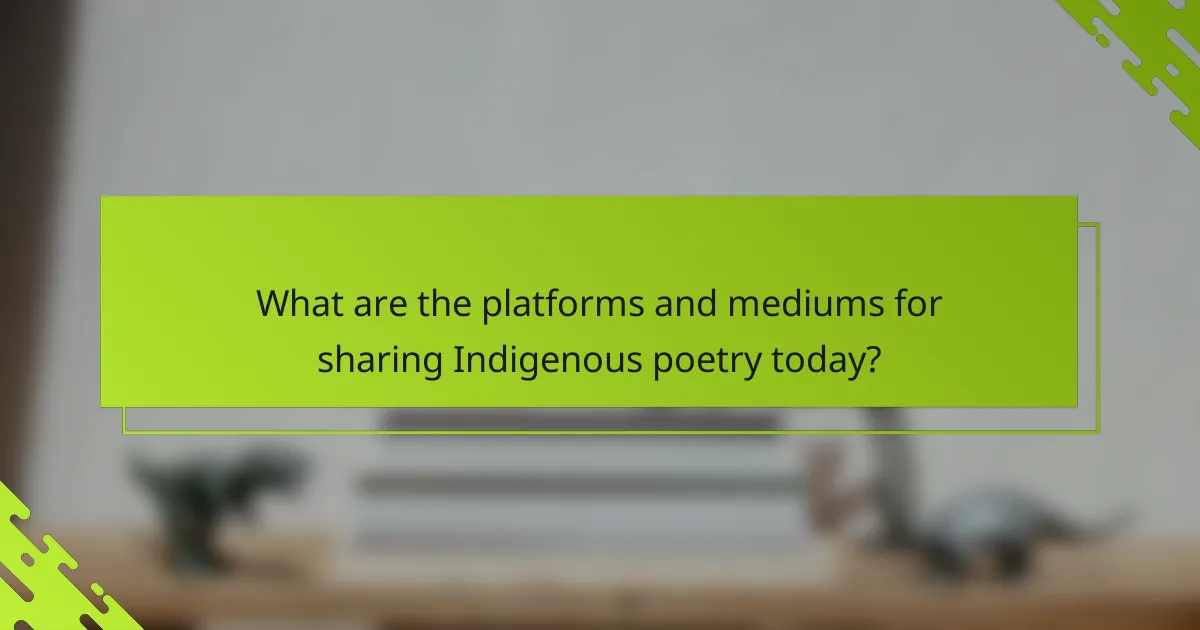
What are the platforms and mediums for sharing Indigenous poetry today?
Indigenous poetry is shared today through diverse platforms and mediums, including social media, literary journals, and community events. Social media platforms like Instagram and Twitter allow poets to reach wider audiences and engage in real-time discussions. Literary journals often feature Indigenous voices, providing a space for published works. Community events, such as open mic nights and festivals, celebrate oral traditions and foster connections. Additionally, podcasts and video platforms showcase performances, enhancing accessibility and visibility for Indigenous poets.
How do social media and digital platforms influence Indigenous poetic expression?
Social media and digital platforms significantly enhance Indigenous poetic expression by providing wider audiences and facilitating cultural exchange. These platforms enable Indigenous poets to share their work beyond traditional boundaries, fostering community engagement.
Digital tools allow for innovative styles, merging oral traditions with contemporary forms. For instance, video poetry and multimedia presentations amplify the emotional resonance of their messages. This integration of technology reflects unique aspects of Indigenous identity and storytelling.
Additionally, social media promotes collaboration among Indigenous poets, enriching the creative landscape. As a result, shared experiences and collective narratives emerge, reinforcing cultural pride and resilience.
Overall, the digital realm empowers Indigenous voices, allowing for diverse expressions that honour traditions while embracing modernity.
What role do literary festivals play in promoting Indigenous poetry?
Literary festivals play a crucial role in promoting Indigenous poetry by providing platforms for visibility and engagement. They showcase diverse voices, foster connections among poets, and educate audiences about Indigenous cultures. These festivals often feature workshops, readings, and discussions that highlight the unique attributes of Indigenous poetry, including its deep cultural reflections and varied styles. As a result, they contribute to a broader appreciation and understanding of Indigenous literary traditions.
What are best practices for engaging with Indigenous poetry respectfully?
Engaging with Indigenous poetry respectfully involves understanding its cultural significance and context. Acknowledge the diverse voices and traditions within Indigenous communities.
Recognise the importance of authenticity by seeking works from Indigenous authors and respecting their perspectives. Approach poetry with an open mind, allowing for personal and collective interpretations.
Participate in discussions or workshops led by Indigenous poets to gain deeper insights. Avoid appropriating language or themes without proper context.
Support Indigenous poetry through promotion and advocacy, ensuring that Indigenous voices are heard and valued in literary spaces.
